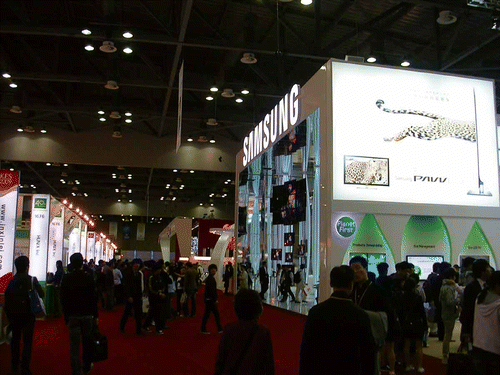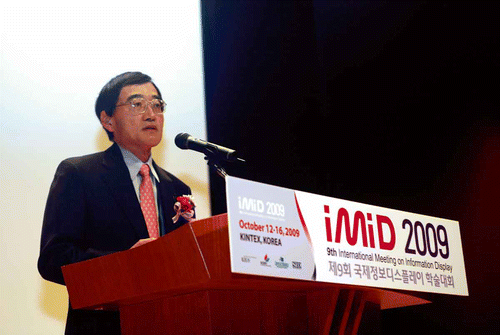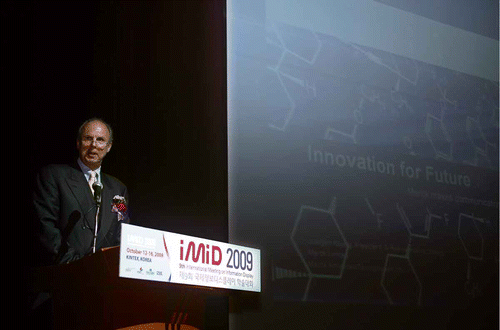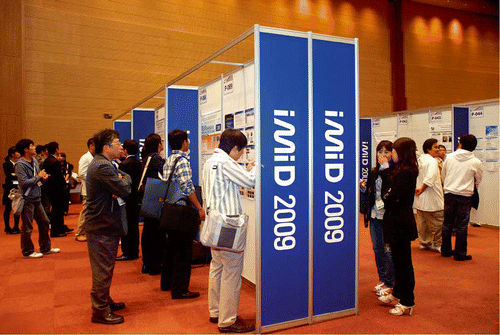9th International Meeting on Information Display, IMID 2009, Korea
The 9th International Meeting on Information Display (IMID 2009) was held at the KINTEX, Korea from 12–16 October 2009. This year's IMID was comprised of the conference, the exhibition and a set of instructive lectures including a workshop and a tutorial. Nearly 2000 participants attended the five-day meeting. The conference featured three keynote addresses and 104 invited talks in 67 oral sessions and two poster sessions. The exhibition was held for four days and featured about 120 distinguished companies specialising in cutting-edge display products, materials and equipment.
The conference started with three keynote addresses. Mr Won-Kie Chang (President of the LCD Division of DS Business, Samsung Electronics Co, Ltd, Korea) began his keynote address by looking back at the growth of the liquid crystal display (LCD) industry over the last 15 years, defining it as a replacement of cathode ray tube (CRT) displays. He said that future advances in the flat panel display (FPD) industry would be affected by value creation in the digital lifestyle. New display devices such as digital signage, interior displays, personal digital boards and e-papers will have an impact on the FPD industry in the future. In addition, he suggested that ultra-high definition, 480 Hz driving, 80-inch screen, interactive and three-dimensional (3D) imaging will be the key technologies in next-generation televisions.
In the second keynote address, Dr Munisamy Anandan (Organic Lighting Technologies LLC, USA) gave an informative talk on the current progress in the technology of the light emitting diode (LED) backlight for LCDs. After explaining the superior performance of LEDs compared to other backlight sources, he focused on technical challenges such as thermal management, improvement of the spectrum in white LEDs and cost reduction. In an effort to overcome such challenges, latest research and development works were presented covering gallium nitride (GaN) growth, efficiency roll-off at high current, vertical LED structure, flip-chip bonding, phosphors for blue LEDs, low cost manufacturing and UV LEDs.
Mr Juergen Koenig (President of Merck Ltd and Merck Advanced Technologies Ltd, Korea) began the third keynote speech by introducing the history of Merck. As the leading manufacturer of display materials, Merck has provided not only liquid crystal materials, but also special materials such as organic light emitting display (OLED) materials, luminescent materials for LEDs and other organic electronic materials. He emphasised that intensive investment is being continued for the development of new materials for the next-generation potential market including displays, photovoltaics and lighting.
Following the keynote addresses, there were a large number of interesting oral and poster presentations on a wide range of leading-edge topics of electronic display technologies including LCD technologies, plasma display panels (PDPs), OLEDs, organic thin-film transistors (OTFTs), flexible displays, e-papers, photovoltaics and 3D displays. Among such diverse topics, a review of the technologies related to liquid crystals will be made.
Recently, bent-core liquid crystals have attracted much attention because they provide a fast response, high contrast ratio and wide-viewing angle properties. One problem in developing a bent-core LCD is that the temperature range of the desired liquid crystal phase is rather high and narrow. Professor Hideo Takezoe from Tokyo Institute of Technology, Japan, reported a variety of newly synthesised bent-core liquid crystals. By mixing a classical bent-core compound and one of the newly synthesised compounds, lowering and widening of the phase temperature have been achieved to some extent.
The electro-optic response has long been a principle issue of LCDs. A fast switching hybrid aligned nematic (HAN) LCD was presented by Professor Lachezar Komitov from the University of Gothenburg, Sweden. Instead of switching the whole bulk of the liquid crystal layer, Komitov proposed flexoelectric coupling combined with a localised electric field. This technique, surface driven switching, does not involve bulk molecules in the switching process so that a fast electro-optic response can be obtained.
You-Jin Lee from Hanyang University, Korea, presented the surface controlled patterned vertical alignment (SC-PVA) mode through surface modification using a reactive mesogen (RM) mixed with the alignment layers. When the RM monomers are polymerised along the direction of the liquid crystal molecules by an applied electric field, their pretilt and azimuthal angles are memorised on the alignment layer. As a result, the SC-PVA display shows improved response time and viewing angle characteristics compared to the conventional PVA modes.
Figure 5. Busy scenes at the exhibitions of approximately 120 companies related to display technology.

In addition, Nemoptic, an e-paper display company, reported high-resolution 6-inch BiNem display prototypes and active-matrix BiNem displays which provide fast operation properties suitable for video applications. Professor Jin Hyun Kwon from Yeungnam University, Korea, presented a colour-filterless LCD by using a compartmentalised RGB LED array and a lenticular lens array.
In the 3D display session, most recent progress in natural 3D display technology was introduced by Professor Yasuhiro Takaki from Tokyo University of Agriculture and Technology, Japan. Unlike the 3D displays based only on binocular disparity, the natural 3D display does not conflict with human 3D perception and minimises visual fatigue. Two types of natural 3D displays, the super multi-view (SMV) display and the high-density directional (HDD) display, were introduced with their up-to-date results such as the time-multiplexing technique and ray saving technique for low-energy displays.
Dr Hee Jin Choi from Samsung Electronics Co, Ltd, Korea, presented the latest LCD driving technology for stereoscopic full high-definition (FHD) display using liquid crystal shutter glasses. According to Choi, the 120 Hz LCD is not suitable for 3D display using liquid crystal shutter glasses due to the 3D crosstalk. This problem can be reduced by insertion of a black frame between left/right image frames using a 240 Hz panel.
Recently, it appears that research in the liquid crystal area is shifting towards creating new types of liquid crystal device by combining them with other materials. For example, an interesting application of liquid crystal to the dye-sensitised solar cell (DSSC) was presented by Hyeonkyung Kim from Dong-A University, Korea. In DSSCs, the liquid electrolyte has been a major field of research because it mediates charge transfer. When the electrolyte is mixed with aligned nematic liquid crystal, according to Kim, the liquid crystal molecules play a role in making the pathway for electron transportation in the cell so that photovoltaic performance of the DSSC can be increased.
This year, the number of papers in liquid crystal technologies was rather less than last year's IMID. Indeed, many presentations in the conference were dedicated to OLED and TFT technologies. Apart from the topics mentioned above, various special topics such as advanced backlight units, touch panels and integral imaging were also discussed. The exhibition was combined with the Korea Electronics Show, making it the largest exhibition in Korea. In the exhibition, ultra-thin LCD televisions with LED backlight, large-sized OLEDs, stereoscopic/autostereoscopic 3D displays, digital information displays (DIDs) and e-paper displays received great attention.
Jong-Ho Hong
School of Electrical Engineering
Seoul National University
Korea



